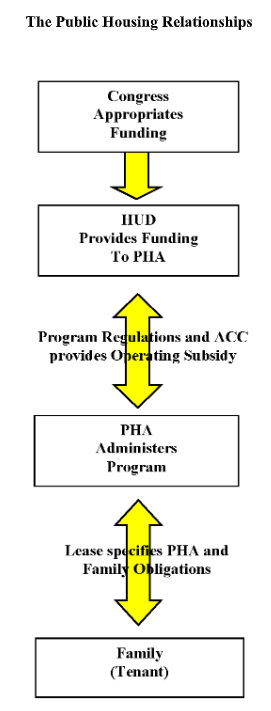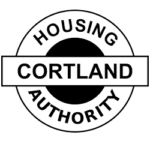What does HUD do?
HUD writes and publishes regulations in order to implement public housing laws enacted by Congress. HUD contracts with the PHA to administer programs in accordance with HUD regulations and provides an operating subsidy to the PHA. The PHA must create written policies that are consistent with HUD regulations. Among these policies is the PHA’s Admissions and Continued Occupancy Policy (ACOP). The ACOP must be approved by the board of commissioners of the PHA.
The job of the PHA pursuant to HUD regulations is to provide decent, safe, and sanitary housing, in good repair, to low-income families at an affordable rent. The PHA screens applicants for public housing and, if they are determined to be eligible for the program, the PHA makes an offer of a housing unit. If the applicant accepts the offer, the PHA and the applicant will enter into a written lease agreement. At this point, the applicant becomes a tenant in the public housing program.
In the context of the public housing program, a tenant is defined as the adult person(s) (other than a live-in aide who (1) executed the lease with the PHA as lessee of the dwelling unit, or, if no such person now resides in the unit, (2) who resides in the unit, and who is the remaining head of household of the tenant family residing in the dwelling unit. [24 CFR 966.53]. The Public Housing Occupancy Guidebook refers to tenants as “residents.” The terms “tenant” and “resident” are used interchangeably in this policy. Additionally, this policy uses the term “family” or “families” for residents or applicants, depending on context. Since the PHA owns the public housing development, the PHA is the landlord. The PHA must comply with all of the legal and management responsibilities of a landlord in addition to administering the program in accordance with HUD regulations and PHA policy.
Federal law is the source of HUD responsibilities. HUD has the following major responsibilities:
-Develop regulations, requirements, handbooks, notices and other guidance to implement housing legislation passed by Congress
-Allocate operating subsidies to PHAs
-Allocate capital funding to PHAs
-Provide technical assistance to PHAs on interpreting and applying program requirements
-Monitor PHA compliance with program requirements and PHA performance in program administration. What does the PHA do? The PHA’s responsibilities originate in federal regulations and the ACC. The PHA owns and manages public housing developments, administers the program under contract with HUD and has the following major responsibilities:
-Ensure compliance with all non-discrimination, equal opportunity, and fair housing laws, and ensure that the program is accessible to persons with disabilities
-Establish local policies and procedures for operating the program
-Accept applications from interested applicant families and determine whether they are income eligible for the program
-Maintain waiting list and select families for admission
-Screen applicant families for suitability as renters
-Maintain housing units by making any necessary repairs in a timely manner
-Make unit offers to families (minimize vacancies without overcrowding)
-Maintain properties to the standard of decent, safe, sanitary, and in good repair (including assuring compliance with uniform physical conditions standards)
-Make sure the PHA has adequate financial resources to maintain its housing stock
-Perform regular reexaminations of family income and composition in accordance with HUD requirements
-Collect rent due from the assisted family and comply with and enforce provisions of the lease
-Ensure that families comply with program rules
-Provide families with prompt and professional service
-Comply with HUD regulations and requirements, the Annual Contributions Contract, HUD- approved applications for funding, the PHA’s ACOP, and other applicable federal, state and local laws.
What does the tenant do?
The tenant’s responsibilities are articulated in the public housing lease. The tenant has the following broad responsibilities:
-Comply with the terms of the lease and PHA house rules, as applicable
-Provide the PHA with complete and accurate information, determined by the PHA to be necessary for administration of the program
-Cooperate in attending all appointments scheduled by the PHA
-Allow the PHA to inspect the unit at reasonable times and after reasonable notice
-Take responsibility for care of the housing unit, including any violations of uniform physical condition standards caused by the family
-Not engage in drug-related or violent criminal activity
-Notify the PHA before moving or termination of the lease
-Use the assisted unit only for residence and as the sole residence of the family. Not sublet the unit or assign the lease
-Promptly notify the PHA of any changes in family composition
-Not commit fraud, bribery, or any other corrupt or criminal act in connection with any housing programs
-Take care of the housing unit and report maintenance problems to the PHA promptly If all parties fulfill their obligations in a professional and timely manner, the program responsibilities will be fulfilled in an effective manner.
The ACOP is the PHA’s written statement of policies used to carry out the housing program in accordance with federal law and regulations, and HUD requirements. The ACOP is required by HUD and it must be available for public review [CFR 24 Part 903]. The ACOP also contains policies that support the objectives contained in the PHA’s Agency Plan. All issues related to public housing not addressed in this ACOP are governed by federal regulations, HUD handbooks and guidebooks, notices and applicable state and local laws. The policies in this ACOP have been designed to ensure compliance with the consolidated ACC and all HUD-approved applications for program funding. The PHA is responsible for complying with all changes in HUD regulations pertaining to public housing. If such changes conflict with this plan, HUD regulations will have precedence.
Public Housing Partnerships
To administer the public housing program, the PHA must enter into an Annual Contributions Contract (ACC) with HUD. The PHA also enters into a contractual relationship with the tenant through the public housing lease. These contracts define and describe the roles and responsibilities of each party. In addition to the ACC, the PHA and family must also comply with federal regulations and other
HUD publications and directives. For the program to work and be successful, all parties involved – HUD, the PHA, and the tenant – play an important role. The chart below illustrates key aspects of these relationships.

Contents of the Policy
Unlike the housing choice voucher program, HUD regulations for public housing do not contain a list of what must be included in the ACOP. However, individual regulations contain requirements of inclusion in the PHA’s written policy. At a minimum, the ACOP plan should cover PHA policies on these subjects:
-The organization of the waiting list and how families are selected and offered available units, including any PHA admission preferences, procedures for removing applicant names from the waiting list, and procedures for closing and reopening the PHA waiting list
-Transfer policies and the circumstances under which a transfer would take precedence over an admission
-Standards for determining eligibility, suitability for tenancy, and the size and type of the unit needed
-Procedures for verifying the information the family has provided
-The method for achieving deconcentrating of poverty and income-mixing of public housing developments
-Grievance procedures
-Policies concerning payment by a family to the PHA of amounts the family owes the PHA
-Interim redeterminations of family income and composition
-Policies regarding community service requirements;
-Polices and rules about safety and ownership of pets in public housing
New Approach to Policy Development
HUD has developed an approach to monitoring PHAs that emphasizes the importance of consistency in operation and decision-making. The ACOP supports that goal by clearly setting forth the PHA’s operating policies. A primary focus of HUD’s Rental Integrity Monitoring (RIM) program has been consistency in how PHAs conduct their business and in how HUD monitors PHA activities. Referring to and following the ACOP is essential to maintaining consistency in applying PHA policy. HUD makes a distinction between mandatory policies and non-mandatory policies:
-Mandatory policies: those driven by legislation, regulations, current handbooks, current PIH notices, and legal opinions from the Office of General Counsel
-Optional, non-binding guidance: includes guidebooks, FAQs, PIH notices that have expired, and recommendations from individual HUD staff. HUD expects PHAs to develop policies and procedures that are consistent with mandatory policies and to make clear the optional policies the PHA has adopted. The ACOP is comprised of mandatory policies and optional PHA policy. HUD’s new direction emphasizes the need for a clearly written and comprehensive ACOP to guide staff in the clear and consistent application of policy. HUD suggestions, recommendations, written issuances, and guidance are consistent with mandatory federal policy. Therefore, using HUD guidance in the preparation of PHA policy, even though it is not mandatory, provides a PHA with a “safe harbor.” If a PHA adopts its own optional policy, it must make its own determination that such policy is consistent with legislation, regulations, and other mandatory requirements. There may be very good reasons for adopting a policy or procedure that is different than that suggested by HUD, but PHAs should carefully think through those decisions and be able to articulate how their policy is consistent with federal laws, regulations and mandatory policy.
Updating and revising the policy
The PHA will revise this ACOP as needed to comply with changes in HUD regulations. The original policy and any changes must be approved by the board of commissioners of the PHA, the pertinent sections included in the Agency Plan, and a copy provided to HUD.
PHA Policy
The PHA will review and update the ACOP as needed to reflect changes in regulations, PHA operations, or when needed to ensure staff consistency in operation.
History of Public Housing
The intent of this section is to provide the public and staff an overview of the history and operation of public housing. The United States Housing Act of 1937 (the “Act”) is responsible for the birth of federal housing program initiatives, known as public housing. The Act was intended to provide financial assistance to states and cities for public works projects, slum clearance and the development of affordable housing for low-income residents. There have been many changes to the program since its inception in 1937. The Housing Act of 1965 established the availability of federal assistance, administered through local public agencies, to provide rehabilitation grants for home repairs and rehabilitation. This act also created the federal Department of Housing and Urban Development (HUD). The Housing Act of 1969 created an operating subsidy for the public housing program for the first time. Until that time, public housing was a self-sustaining program. In 1998, the Quality Housing and Work Responsibility Act (QHWRA) – also known as the Public Housing Reform Act or Housing Act of 1998 – was signed into law. Its purpose was to provide more private sector management guidelines to the public housing program and provide residents with greater choices. It also allowed PHAs more remedies to replace or revitalize severely distressed public housing developments. Highlights of the Reform Act include: the establishment of flat rents; the requirement for PHAs to develop five-year and annual plans; income targeting, a requirement that 40% of all new admissions in public housing during any given fiscal year be reserved for extremely low-income families; and resident self-sufficiency incentives.
